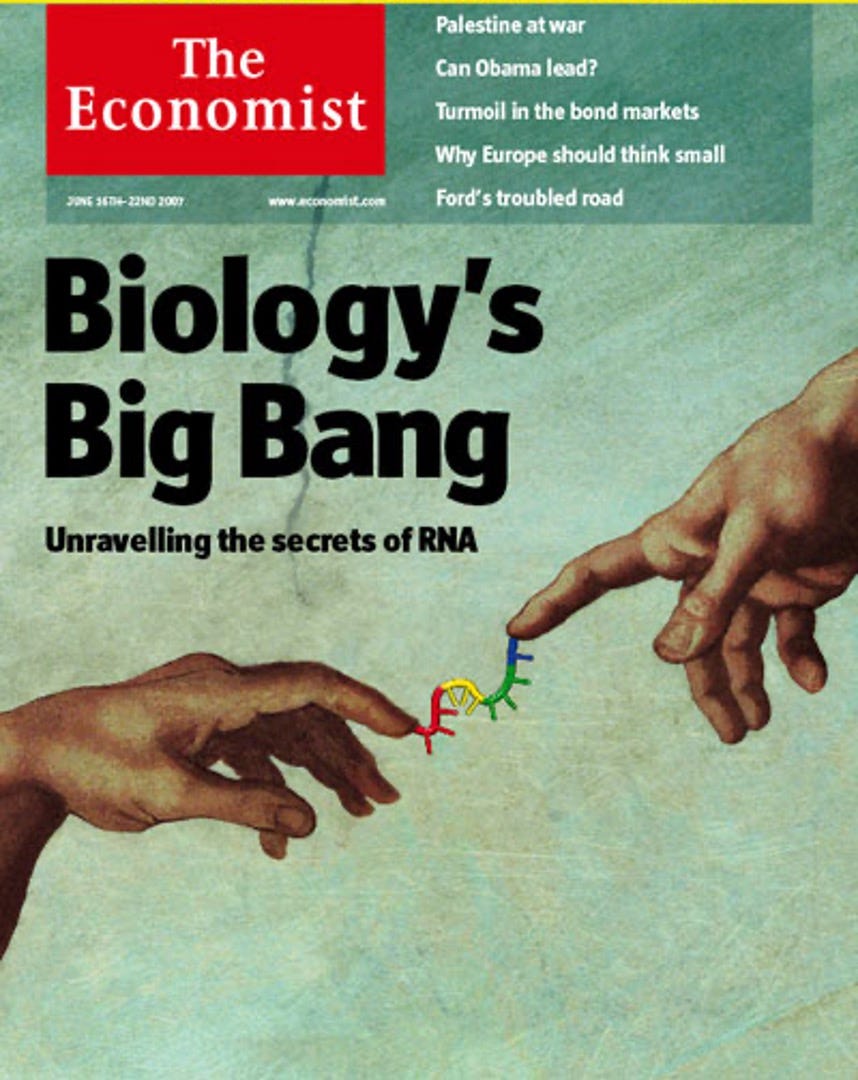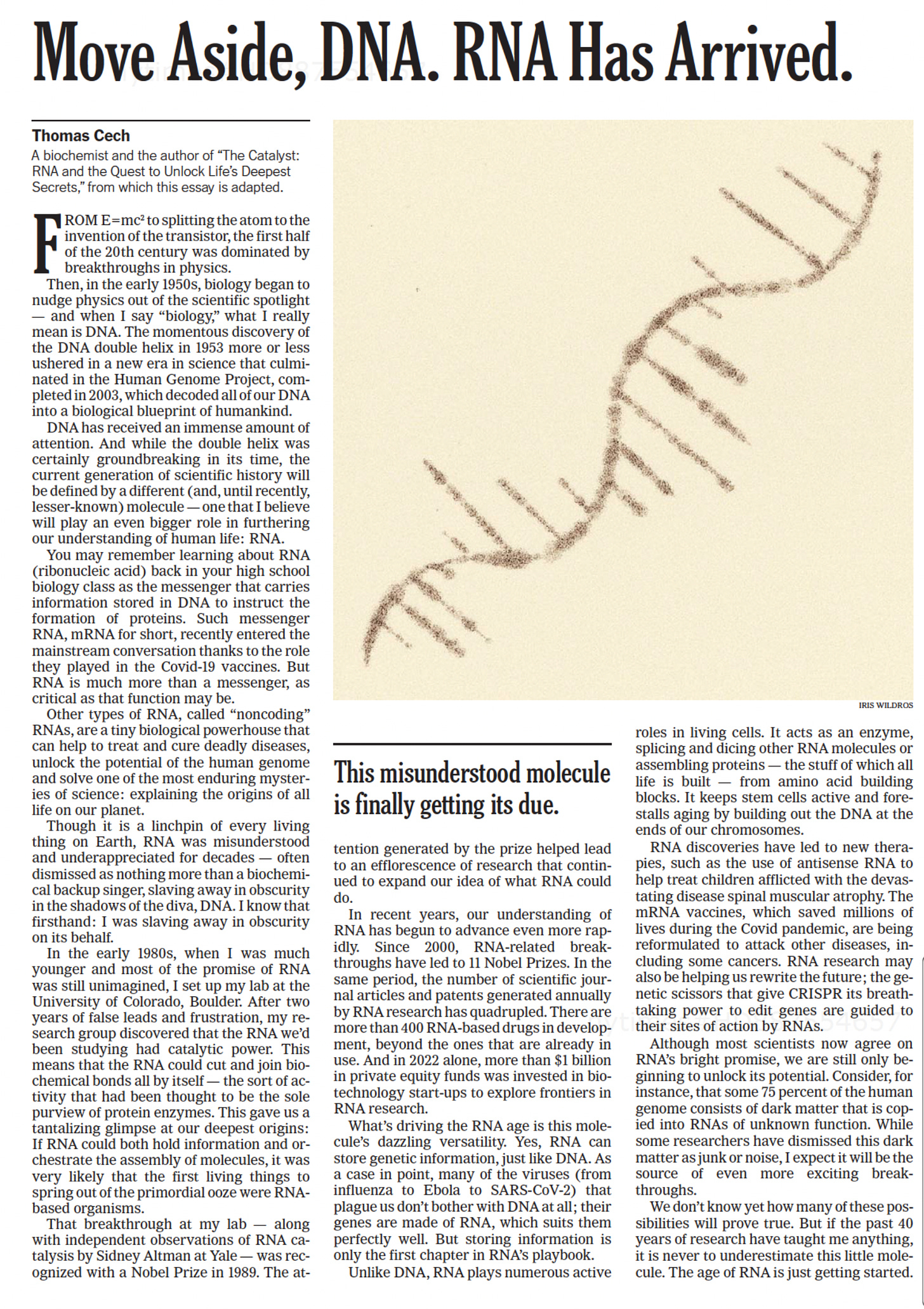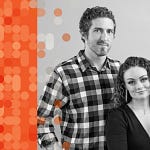In this podcast, Thomas Czech, Distinguished Professor at the University of Colorado, Boulder, with a lineage of remarkable contributions on RNA, ribozyme, and telomeres, discuss why RNA is so incredibly versatile.
Video snippet from our conversation. Full videos of all Ground Truths podcasts can be seen on YouTube here. The audios are also available on Apple and Spotify.
Transcript with links to the audio and external links
Eric Topol (00:07):
Well, hello, this is Eric Topol from Ground Truths, and it's really a delight for me to welcome Tom Cech who just wrote a book, the Catalyst, and who is a Nobel laureate for his work in RNA. And is at the University of Colorado Boulder as an extraordinary chemist and welcome Tom.
Tom Cech (00:32):
Eric, I'm really pleased to be here.
The RNA Guy
Eric Topol (00:35):
Well, I just thoroughly enjoyed your book, and I wanted to start out, if I could, with a quote, which gets us right off the story here, and let me just get to it here. You say, “the DNA guy would need to become an RNA guy. Though I didn’t realize it at the time, jumping ship would turn out to be the most momentous decision in my life.” Can you elaborate a bit on that?
Tom Cech (01:09):
As a graduate student at Berkeley, I was studying DNA and chromosomes. I thought that DNA was king and really somewhat belittled the people in the lab next door who were working on RNA, I thought it was real sort of second fiddle material. Of course, when RNA is acting just as a message, which is an important function, a critical function in all life on earth, but still, it's a function that's subservient to DNA. It's just copying the message that's already written in the playbook of DNA. But little did I know that the wonders of RNA were going to excite me and really the whole world in unimaginable ways.
Eric Topol (02:00):
Well, they sure have, and you've lit up the world well before you had your Nobel Prize in 1989 was Sid Altman with ribozyme. And I think one of the things that struck me, which are so compelling in the book as I think people might know, it's divided in two sections. The first is much more on the biology, and the second is much more on the applications and how it's changing the world. We'll get into it particularly in medicine, but the interesting differentiation from DNA, which is the one trick pony, as you said, all it does is store stuff. And then the incredible versatility of RNA as you discovered as a catalyst, that challenging dogma, that proteins are supposed to be the only enzymes. And here you found RNA was one, but also so much more with respect to genome editing and what we're going to get into here. So I thought what we might get into is the fact that you kind of went into the scum of the pond with this organism, which by the way, you make a great case for the importance of basic science towards the end of the book. But can you tell us about how you, and then of course, many others got into the Tetrahymena thermophila, which I don't know that much about that organism.
Tom Cech (03:34):
Yeah, it's related to Tetrahymena is related to paramecium, which is probably more commonly known because it's an even larger single celled animal. And therefore, in an inexpensive grade school microscope, kids can look through and see these ciliated protozoa swimming around on a glass slide. But I first learned about them when I was a postdoc at MIT and I would drive down to Joe Gall's lab at Yale University where Liz Blackburn was a postdoc at the time, and they were all studying Tetrahymena. It has the remarkable feature that it has 10,000 identical copies of a particular gene and for a higher organism, one that has its DNA in the nucleus and does its protein synthesis in the cytoplasm. Typically, each gene's present in two copies, one from mom, one from dad. And if you're a biochemist, which I am having lots of stuff is a real advantage. So 10,000 copies of a particular gene pumping out RNA copies all the time was a huge experimental advantage. And that's what I started working on when I started my own lab at Boulder.
Eric Topol (04:59):
Well, and that's where, I guess the title of the book, the Catalyst ultimately, that grew into your discovery, right?
Tom Cech (05:08):
Well, at one level, yes, but I also think that the catalyst in a more general conversational sense means just facilitating life in this case. So RNA does much more than just serve as a biocatalyst or a message, and we'll get into that with genome editing and with telomerase as well.
The Big Bang and 11 Nobel Prizes on RNA since 2000
Eric Topol (05:32):
Yes, and I should note that as you did early in the book, that there's been an 11 Nobel prize awardees since 2000 for RNA work. And in fact, we just had Venki who I know you know very well as our last podcast. And prior to that, Kati Karikó, Jennifer Doudna who worked in your lab, and the long list of people working RNA in the younger crowd like David Liu and Fyodor Urnov and just so many others, we need to have an RNA series because it's just exploding. And that one makes me take you back for a moment to 2007. And when I was reading the book, it came back to me about the Economist cover. You may recall almost exactly 17 years ago. It was called the Biology’s Big Bang – Unravelling the secrets of RNA. And in that, there was a notable quote from that article. Let me just get to that. And it says, “it is probably no exaggeration to say that biology is now undergoing its neutron moment.”
(06:52):
This is 17 years ago. “For more than half a century the fundamental story of living things has been a tale of the interplay between genes, in the form of DNA, and proteins, which is genes encode and which do the donkey work of keeping living organisms living. The past couple of years, 17 years ago, however, has seen the rise and rise of a third type of molecule, called RNA.” Okay, so that was 2007. It's pretty extraordinary. And now of course we're talking about the century of biology. So can you kind of put these last 17 years in perspective and where we're headed?
Tom Cech (07:34):
Well, Eric, of course, this didn't all happen in one moment. It wasn't just one big bang. And the scientific community has been really entranced with the wonders of RNA since the 1960s when everyone was trying to figure out how messenger RNA stored the genetic code. But the general public has been really kept in the dark about this, I think. And as scientists, were partially to blame for not reaching out and sharing what we have found with them in a way that's more understandable. The DNA, the general public's very comfortable with, it's the stuff of our heredity. We know about genetic diseases, about tracing our ancestry, about solving crimes with DNA evidence. We even say things like it's in my DNA to mean that it's really fundamental to us. But I think that RNA has been sort of kept in the closet, and now with the mRNA vaccines against Covid-19, at least everyone's heard of RNA. And I think that that sort of allowed me to put my foot in the door and say, hey, if you were curious about the mRNA vaccines, I have some more stories for you that you might be really interested in.
RNA vs RNA
Eric Topol (09:02):
Yeah, well, we'll get to that. Maybe we should get to that now because it is so striking the RNA versus RNA chapter in your book, and basically the story of how this RNA virus SARS-CoV-2 led to a pandemic and it was fought largely through the first at scale mRNA nanoparticle vaccine package. Now, that takes us back to some seminal work of being able to find, giving an mRNA to a person without inciting massive amount of inflammation and the substitution of pseudouridine or uridine in order to do that. Does that really get rid of all the inflammation? Because obviously, as you know, there's been some negativism about mRNA vaccines for that and also for the potential of not having as much immune cell long term activation. Maybe you could speak to that.
Tom Cech (10:03):
Sure. So the discovery by Kati Karikó and Drew Weissman of the pseudouridine substitution certainly went a long way towards damping down the immune response, the inflammatory response that one naturally gets with an RNA injection. And the reason for that is that our bodies are tuned to be on the lookout for foreign RNA because so many viruses don't even mess with DNA at all. They just have a genome made of RNA. And so, RNA replicating itself is a danger sign. It means that our immune system should be on the lookout for this. And so, in the case of the vaccination, it's really very useful to dampen this down. A lot of people thought that this might make the mRNA vaccines strange or foreign or sort of a drug rather than a natural substance. But in fact, modified nucleotides, nucleotides being the building blocks of RNA, so these modified building blocks such as pseudoU, are in fact found in natural RNAs more in some than in others. And there are about 200 modified versions of the RNA building blocks found in cells. So it's really not an unusual modification or something that's all that foreign, but it was very useful for the vaccines. Now your other question Eric had to do with the, what was your other question, Eric?
Eric Topol (11:51):
No, when you use mRNA, which is such an extraordinary way to get the spike protein in a controlled way, exposed without the virus to people, and it saved millions of lives throughout the pandemic. But the other question is compared to other vaccine constructs, there's a question of does it give us long term protective immunity, particularly with T cells, both CD8 cytotoxic, maybe also CD4, as I know immunology is not your main area of interest, but that's been a rub that's been put out there, that it isn't just a weaning of immunity from the virus, but also perhaps that the vaccines themselves are not as good for that purpose. Any thoughts on that?
Tom Cech (12:43):
Well, so my main thought on that is that this is a property of the virus more than of the vaccine. And respiratory viruses are notoriously hard to get long-term immunity. I mean, look at the flu virus. We have to have annual flu shots. If this were like measles, which is a very different kind of virus, one flu shot would protect you against at least that strain of flu for the rest of your life. So I think the bad rap here is not the vaccine's fault nearly as much as it's the nature of respiratory viruses.
RNA And Aging
Eric Topol (13:27):
No, that's extremely helpful. Now, let me switch to an area that's really fascinating, and you've worked quite a bit on the telomerase story because this is, as you know, being pursued quite a bit, has thought, not just because telomeres might indicate something about biologic aging, but maybe they could help us get to an anti-aging remedy or whatever you want to call it. I'm not sure if you call it a treatment, but tell us about this important enzyme, the role of the RNA building telomeres. And maybe you could also connect that with what a lot of people might not be familiar with, at least from years ago when they learned about it, the Hayflick limit.
Tom Cech (14:22):
Yes. Well, Liz Blackburn and Carol Greider got the Nobel Prize for the discovery of telomerase along with Jack Szostak who did important initial work on that system. And what it does is, is it uses an RNA as a template to extend the ends of human chromosomes, and this allows the cell to keep dividing without end. It gives the cell immortality. Now, when I say immortality, people get very excited, but I'm talking about immortality at the cellular level, not for the whole organism. And in the absence of a mechanism to build out the ends of our chromosomes, the telomeres being the end of the chromosome are incompletely replicated with each cell division. And so, they shrink over time, and when they get critically short, they signal the cell to stop dividing. This is what is called the Hayflick limit, first discovered by Leonard Hayflick in Philadelphia.
(15:43):
And he, through his careful observations on cells, growing human cells growing in Petri dishes, saw that they could divide about 50 times and then they wouldn't die. They would just enter a state called senescence. They would change shape, they would change their metabolism, but they would importantly quit dividing. And so, we now see this as a useful feature of human biology that this protects us from getting cancer because one of the hallmarks of cancer is immortality of the tumor cells. And so, if you're wishing for your telomeres to be long and your cells to keep dividing, you have to a little bit be careful what you wish for because this is one foot in the door for cancer formation.
Eric Topol (16:45):
Yeah, I mean, the point is that it seems like the body and the cell is smart to put these cells into the senescent state so they can't divide anymore. And one of the points you made in the book that I think is worth noting is that 90% of cancers have the telomerase, how do you say it?
Tom Cech (17:07):
Telomerase.
Eric Topol (17:08):
Yeah, reactivate.
Tom Cech (17:09):
Right.
Eric Topol (17:10):
That's not a good sign.
Tom Cech (17:12):
Right. And there are efforts to try to target telomerase enzyme for therapeutic purposes, although again, it's tricky because we do have stem cells in our bodies, which are the exception to the Hayflick limit rule. They do still have telomerase, they still have to keep dividing, maybe not as rapidly as a cancer cell, but they still keep dividing. And this is critical for the replenishment of certain worn out tissues in our such as skin cells, such as many of our blood cells, which may live only 30 days before they poop out. That's a scientific term for needing to be replenished, right?
Eric Topol (18:07):
Yeah. Well, that gets me to the everybody's, now I got the buzz about anti-aging, and whether it's senolytics to get rid of these senescent cells or whether it's to rejuvenate the stem cells that are exhausted or work on telomeres, all of these seem to connect with a potential or higher risk of cancer. I wonder what your thoughts are as we go forward using these various biologic constructs to be able to influence the whole organism, the whole human body aging process.
Tom Cech (18:47):
Yes. My view, and others may disagree is that aging is not an affliction. It's not a disease. It's not something that we should try to cure, but what we should work on is having a healthy life into our senior years. And perhaps you and I are two examples of people who are at that stage of our life. And what we would really like is to achieve, is to be able to be active and useful to society and to our families for a long period of time. So using the information about telomerase, for example, to help our stem cells stay healthy until we are, until we're ready to cash it in. And for that matter on the other side of the coin, to try to inhibit the telomerase in cancer because cancer, as we all know, is a disease of aging, right? There are young people who get cancer, but if you look at the statistics, it's really heavily weighted towards people who've been around a long time because mutations accumulate and other damage to cells that would normally protect against cancer accumulates. And so, we have to target both the degradation of our stem cells, but also the occurrence of cancer, particularly in the more senior population. And knowing more about RNA is really helpful in that regard.
RNA Drugs
Eric Topol (20:29):
Yeah. Well, one of the things that comes across throughout the book is versatility of RNA. In fact, you only I think, mentioned somewhere around 12 or 14 of these different RNAs that have a million different shapes, and there's so many other names of different types of RNAs. It's really quite extraordinary. But one of the big classes of RNAs has really hit it. In fact, this week there are two new interfering RNAs that are having extraordinary effects reported in the New England Journal on all the lipids, abnormal triglycerides and LDL cholesterol, APOC3. And can you talk to us about this interfering the small interfering RNAs and how they become, you've mentioned in the book over 400 RNAs are in the clinic now.
Tom Cech (21:21):
Yeah, so the 400 of course is beyond just the siRNAs, but these, again, a wonderful story about how fundamental science done just to understand how nature works without any particular expectation of a medical spinoff, often can have the most phenomenal and transformative effects on medicine. And this is one of those examples. It came from a roundworm, which is about the size of an eyelash, which a scientist named Sydney Brenner in England had suggested would be a great experimental organism because the entire animal has only about a thousand cells, and it's transparent so we can look at, see where the cells are, we can watch the worm develop. And what Andy Fire and Craig Mello found in this experimental worm was that double-stranded RNA, you think about DNA is being double-stranded and RNA as being single stranded. But in this case, it was an unusual case where the RNA was forming a double helix, and these little pieces of double helical RNA could turn off the expression of genes in the worm.
(22:54):
And that seemed remarkable and powerful. But as often happens in biology, at least for those of us who believe in evolution, what goes for the worm goes for the human as well. So a number of scientists quickly found that the same process was going on in the human body as a natural way of regulating the expression of our genes, which means how much of a particular gene product is actually going to be made in a particular cell. But not only was it a natural process, but you could introduce chemically synthesized double helical RNAs. There are only 23 base pairs, 23 units of RNA long, so they're pretty easy to chemically synthesize. And that once these are introduced into a human, the machinery that's already there grabs hold of them and can be used to turn off the expression of a disease causing RNA or the gene makes a messenger RNA, and then this double-stranded RNA can suppress its action. So this has become the main company that is known for doing this is Alnylam in Boston, Cambridge. And they have made quite a few successful products based on this technology.
Eric Topol (24:33):
Oh, absolutely. Not just for amyloidosis, but as I mentioned these, they even have a drug that's being tested now, as you know that you could take once or twice a year to manage your blood pressure. Wouldn't that be something instead of a pill every day? And then of course, all these others that are not just from Alnylam, but other companies I wasn't even familiar with for managing lipids, which is taking us well beyond statins and these, so-called PCSK9 monoclonal antibodies, so it's really blossoming. Now, the other group of RNA drugs are antisense drugs, and it seemed like they took forever to warm up, and then finally they hit. And can you distinguish the antisense versus the siRNA therapeutics?
Tom Cech (25:21):
Yes, in a real general sense, there's some similarity as well as some differences, but the antisense, what are called oligonucleotides, whoa, that's a big word, but oligo just means a few, right? And nucleotides is just the building blocks of nucleic acid. So you have a string of a few of these. And again, it's the power of RNA that it is so good at specifically base pairing only with matching sequences. So if you want to match with a G in a target messenger RNA, you put a C in the antisense because G pairs with C, if you want to put an A, if want to match with an A, you put a U in the antisense because A and U form a base pair U is the RNA equivalent of T and DNA, but they have the same coding capacity. So any school kid can write out on a notepad or on their laptop what the sequence would have to be of an antisense RNA to specifically pair with a particular mRNA.
(26:43):
And this has been, there's a company in your neck of the woods in the San Diego area. It started out with the name Isis that turned out to be the wrong Egyptian God to name your company after, so they're now known as Ionis. Hopefully that name will be around for a while. But they've been very successful in modifying these antisense RNAs or nucleic acids so that they are stable in the body long enough so that they can pair with and thereby inhibit the expression of particular target RNAs. So it has both similarities and differences from the siRNAs, but the common denominator is RNA is great stuff.
RNA and Genome Editing
Eric Topol (27:39):
Well, you have taken that to in catalyst, the catalyst, you've proven that without a doubt and you and so many other extraordinary scientists over the years, cumulatively. Now, another way to interfere with genes is editing. And of course, you have a whole chapter devoted to not just well CRISPR, but the whole genome editing field. And by the way, I should note that I forgot because I had read the Codebreaker and we recently spoke Jennifer Doudna and I, that she was in your lab as a postdoc and you made some wonderful comments about her. I don't know if you want to reflect about having Jennifer, did you know that she was going to do some great things in her career?
Tom Cech (28:24):
Oh, there was no question about it, Eric. She had been a star graduate student at Harvard, had published a series of breathtaking papers in magazines such as Science and Nature already as a graduate student. She won a Markey fellowship to come to Colorado. She chose a very ambitious project trying to determine the molecular structures of folded RNA molecules. We only had one example at the time, and that was the transfer RNA, which is involved in protein synthesis. And here she was trying these catalytic RNAs, which we had discovered, which were much larger than tRNA and was making great progress, which she finished off as an assistant professor at Yale. So what the general public may not know was that in scientific, in the scientific realm, she was already highly appreciated and much awarded before she even heard anything about CRISPR.
Eric Topol (29:38):
Right. No, it was a great line you have describing her, “she had an uncanny talent for designing just the right experiment to test any hypothesis, and she possessed more energy and drive than any scientist I'd ever met.” That's pretty powerful. Now getting into CRISPR, the one thing, it's amazing in just a decade to see basically the discovery of this natural system to then be approved by FDA for sickle cell disease and beta thalassemia. However, the way it exists today, it's very primitive. It's not actually fixing the gene that's responsible, it's doing a workaround plan. It's got double strand breaks in the DNA. And obviously there's better ways of editing, which are going to obviously involve RNA epigenetic editing, if you will as well. What is your sense about the future of genome editing?
Tom Cech (30:36):
Yeah, absolutely, Eric. It is primitive right now. These initial therapies are way too expensive as well to make them broadly applicable to the entire, even in a relatively wealthy country like the United States, we need to drive the cost down. We need to get them to work, we need to get the process of introducing them into the CRISPR machinery into the human body to be less tedious and less time consuming. But you've got to start somewhere. And considering that the Charpentier and Doudna Nobel Prize winning discovery was in 2012, which is only a dozen years ago, this is remarkable progress. More typically, it takes 30 years from a basic science discovery to get a medical product with about a 1% chance of it ever happening. And so, this is clearly a robust RNA driven machine. And so, I think the future is bright. We can talk about that some more, but I don't want to leave RNA out of this conversation, Eric. So what's cool about CRISPR is its incredible specificity. Think of the human genome as a million pages of text file on your computer, a million page PDF, and now CRISPR can find one sentence out of that million pages that matches, and that's because it's using RNA, again, the power of RNA to form AU and GC base pairs to locate just one site in our whole DNA, sit down there and direct this Cas9 enzyme to cut the DNA at that site and start the repair process that actually does the gene editing.
Eric Topol (32:41):
Yeah, it's pretty remarkable. And the fact that it can be so precise and it's going to get even more precise over time in terms of the repair efforts that are needed to get it back to an ideal state. Now, the other thing I wanted to get into with you a bit is on the ribosome, because that applies to antibiotics and as you call it, the mothership. And I love this metaphor that you had about the ribosome, and in the book, “the ribosome is your turntable, the mRNA is the vinyl LP record, and the protein is the music you hear when you lower the needle.” Tell us more about the ribosome and the role of antibiotics.
Tom Cech (33:35):
So do you think today's young people will understand that metaphor?
Eric Topol (33:40):
Oh, they probably will. They're making a comeback. These records are making a comeback.
Tom Cech (33:44):
Okay. Yes, so this is a good analogy in that the ribosome is so versatile it's able to play any music that you feed at the right messenger RNA to make the music being the protein. So you can have in the human body, we have tens of thousands of different messenger RNAs. Each one threads through the same ribosome and spills out the production of whatever protein matches that mRNA. And so that's pretty remarkable. And what Harry Noller at UC Santa Cruz and later the crystallographers Venki Ramakrishnan, Tom Steitz, Ada Yonath proved really through their studies was that this is an RNA machine. It was hard to figure that out because the ribosome has three RNAs and it has dozens of proteins as well. So for a long time people thought it must be one of those proteins that was the heart and soul of the record player, so to speak.
RNA and Antibiotics
(34:57):
And it turned out that it was the RNA. And so, when therefore these scientists, including Venki who you just talked to, looked at where these antibiotics docked on the ribosome, they found that they were blocking the key functional parts of the RNA. So it was really, the antibiotics knew what they were doing long before we knew what they were doing. They were talking to and obstructing the action of the ribosomal RNA. Why is this a good thing for us? Because bacterial ribosomes are just enough different from human ribosomes that there are drugs that will dock to the bacterial ribosomal RNA, throw a monkey wrench into the machine, prevent it from working, but the human ribosomes go on pretty much unfazed.
Eric Topol (36:00):
Yeah, no, the backbone of our antibiotics relies on this. So I think people need to understand about the two subunits, the large and the small and this mothership, and you illuminate that so really well in the book. That also brings me to phage bacteria phage, and we haven't seen that really enter the clinic in a significant way, but there seems to be a great opportunity. What's your view about that?
Tom Cech (36:30):
This is an idea that goes way back because since bacteria have their own viruses which do not infect human cells, why not repurpose those into little therapeutic entities that could kill, for example, what would we want to kill? Well, maybe tuberculosis has been very resistant to drugs, right? There are drug resistant strains of TB, yes, of TB, tuberculosis, and especially in immunocompromised individuals, this bug runs rampant. And so, I don't know the status of that. It's been challenging, and this is the way that biomedicine works, is that for every 10 good ideas, and I would say phage therapy for bacterial disease is a good idea. For every 10 such ideas, one of them ends up being practical. And the other nine, maybe somebody else will come along and find a way to make it work, but it hasn't been a big breakthrough yet.
RNA, Aptamers and Proteins
Eric Topol (37:54):
Yeah, no, it's really interesting. And we'll see. It may still be in store. What about aptamers? Tell us a little bit more about those, because they have been getting used a lot in sorting out the important plasma proteins as therapies. What are aptamers and what do you see as the future in that regard?
Tom Cech (38:17):
Right. Well, in fact, aptamers are a big deal in Boulder because Larry Gold in town was one of the discoverers has a company making aptamers to recognize proteins. Jack Szostak now at University of Chicago has played a big role. And also at your own institution, Jerry Joyce, your president is a big aptamer guy. And you can evolution, normally we think about it as happening out in the environment, but it turns out you can also make it work in the laboratory. You can make it work much faster in the laboratory because you can set up test tube experiments where molecules are being challenged to perform a particular task, like for example, binding to a protein to inactivate it. And if you make a large community of RNA molecules randomly, 99.999% of them aren't going to know how to do this. What are the odds? Very low.
(39:30):
But just by luck, there will be an occasional molecule of RNA that folds up into a shape that actually fits into the proteins active sighting throws a monkey wrench into the works. Okay, so now that's one in a billion. How are you going to find that guy? Well, this is where the polymerase chain reaction, the same one we use for the COVID-19 tests for infection comes into play. Because if you can now isolate this needle in a haystack and use PCR to amplify it and make a whole handful of it, now you've got a whole handful of molecules which are much better at binding this protein than the starting molecule. And now you can go through this cycle several times to enrich for these, maybe mutagen it a little bit more to give it a little more diversity. We all know diversity is good, so you put a little more diversity into the population and now you find some guy that's really good at recognizing some disease causing protein. So this is the, so-called aptamer story, and they have been used therapeutically with some success, but diagnostically certainly they are extremely useful. And it's another area where we've had success and the future could hold even more success.
Eric Topol (41:06):
I think what you're bringing up is so important because the ability to screen that tens of thousands of plasma proteins in a person and coming up with as Tony Wyss-Coray did with the organ clocks, and this is using the SomaLogic technology, and so much is going on now to get us not just the polygenic risk scores, but also these proteomic scores to compliment that at our orthogonal, if you will, to understand risk of people for diseases so we can prevent them, which is fulfilling a dream we've never actually achieved so far.
Tom Cech (41:44):
Eric, just for full disclosure, I'm on the scientific advisory board of SomaLogic in Boulder. I should disclose that.
Eric Topol (41:50):
Well, that was smart. They needed to have you, so thank you for mentioning that. Now, before I wrap up, well, another area that is a favorite of mine is citizen science. And you mentioned in the book a project because the million shapes of RNA and how it can fold with all hairpin terms turns and double stranded and whatever you name it, that there was this project eteRNA that was using citizen scientists to characterize and understand folding of RNA. Can you tell us about that?
RNA Folding and Citizen Science
Tom Cech (42:27):
So my friend Rhiju Das, who's a professor at Stanford University, sort of adopted what had been done with protein folding by one of his former mentors, David Baker in Seattle, and had repurposed this for RNA folding. So the idea is to come up with a goal, a target for the community. Can you design an RNA that will fold up to look like a four pointed cross or a five pointed star? And it turned out that, so they made it into a contest and they had tens of thousands of people playing these games and coming up with some remarkable solutions. But then they got a little bit more practical, said, okay, that was fun, but can we have the community design something like a mRNA for the SARS-CoV-2 spike protein to make maybe a more stable vaccine? And quite remarkably, the community of many of whom are just gamers who really don't know much about what RNA does, were able to find some solutions. They weren't enormous breakthroughs, but they got a several fold, several hundred percent increase in stability of the RNA by making it fold more tightly. So I just find it to be a fascinating approach to science. Somebody of my generation would never think of this, but I think for today's generation, it's great when citizens can become involved in research at that level.
Eric Topol (44:19):
Oh, I think it's extraordinary. And of course, there are other projects folded and others that have exemplified this ability for people with no background in science to contribute in a meaningful way, and they really enjoy, it's like solving a puzzle. The last point is kind of the beginning, the origin of life, and you make a pretty strong case, Tom, that it was RNA. You don't say it definitively, but maybe you can say it here.
RNA and the Origin of Life
Tom Cech (44:50):
Well, Eric, the origin of life happening almost 4 billion years ago on our primitive planet is sort of a historical question. I mean, if you really want to know what happened then, well, we don't have any video surveillance of those moments. So scientists hate to ever say never, but it's hard to sort of believe how we would ever know for sure. So what Leslie Orgel at the Salk Institute next to you taught me when I was a starting assistant professor is even though we'll never know for sure, if we can recapitulate in the laboratory plausible events that could have happened, and if they make sense chemically and biologically, then that's pretty satisfying, even if we can never be absolutely sure. That's what a number of scientists have done in this field is to show that RNA is sort of a, that all the chemistry sort of points to RNA as being something that could have been made under prebiotic conditions and could have folded up into a way that could solve the greatest of all chicken and egg problems, which came first, the informational molecule to pass down to the next generation or the active molecule that could copy that information.
(46:32):
So now that we know that RNA has both of those abilities, maybe at the beginning there was just this RNA world RNA copying itself, and then proteins came along later, and then DNA probably much more recently as a useful but a little bit boring of genetic information, right?
Eric Topol (46:59):
Yeah. Well, that goes back to that cover of the Economist 17 years ago, the Big Bang, and you got me convinced that this is a pretty strong story and candidate. Now what a fun chance to discuss all this with you in an extraordinary book, Tom. Did I miss anything that you want to bring up?
Tom Cech (47:21):
Eric, I just wanted to say that I not only appreciate our conversation, but I also appreciate all you are doing to bring science to the non-scientist public. I think people like me who have taught a lot of freshmen in chemistry, general chemistry, sort of think that that’s the level that we need to aim at. But I think that those kids have had science in high school year after year. We need to aim at the parents of those college freshmen who are intelligent, who are intellectually curious, but have not had science courses in a long time. And so, I'm really joining with you in trying to avoid jargon as much as possible. Use simple language, use analogies and metaphors, and try to share the excitement of what we're doing in the laboratory with the populace.
Eric Topol (48:25):
Well, you sure did that it was palpable. And I thought about it when I read the book about how lucky it would be to be a freshman at the University of Boulder and be having you as the professor. My goodness. Well, thank you so much. This has been so much fun, Tom, and I hope everybody's going to get out there and read the Catalyst to get all the things that we didn't even get a chance to dive into. But this has been great and look forward to future interactions with you.
Tom Cech (48:53):
Take care, Eric.
*********************
Thanks for listening or reading this edition of Ground Truths.
Please share this podcast with your friends and network. That tells me you found it informative and makes the effort in doing these worthwhile.
All Ground Truths newsletters and podcast are free. Voluntary paid subscriptions all go to support Scripps Research. Many thanks for that—they greatly helped fund our summer internship programs for 2023 and 2024.
Thanks to my producer Jessica Nguyen and Sinjun Balabanoff for audio and video support at Scripps Research.
Note: you can select preferences to receive emails about newsletters, podcasts, or all I don’t want to bother you with an email for content that you’re not interested in.















Share this post